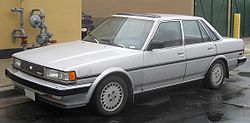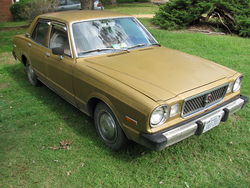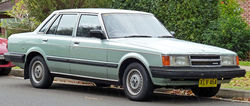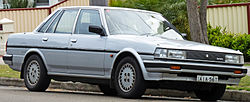- Toyota Cressida
-
Toyota Cressida 
Manufacturer Toyota Production 1976–1992 Assembly Toyota City, Japan Predecessor Toyota Crown (North America) Successor Toyota Vienta (Australia)
Toyota Avalon (North America)Class Mid-size Layout FR layout Related Toyota Corona Mark II, Toyota Mark II, Toyota Chaser, Toyota Cresta The Toyota Cressida was a mid-size sedan marketed by Toyota from December 1976[1] to February 1993 through four generations. It was the flagship sedan of Toyota in the United States. The same chassis with slightly different bodies was available in other countries as the Toyota Mark II, Toyota Chaser and Toyota Cresta. The Cressida name was retired in 1992 (1993 in Australia), but the chassis and Mark II, Chaser, and Cresta names continued production in Japan until the early 2000s. In total, Toyota sold 353,053 Cressidas in the United States.
The Cressida was available worldwide in a variety of body styles and engines — including the 6 cylinder G-series, M-series, and the 4 cylinder R-series gasoline engines, as well as the 4 cylinder L series diesel.
The name "Cressida" derives from the lead character in William Shakespeare's play Troilus and Cressida.
Contents
First generation (X30, X40; 1976–1980)
First generation 
Production Dec 1976[1]–Aug 1980[1] Model years 1977–1980 Body style 2-door coupe
4-door sedan
4-door station wagonEngine 1.8 L 3T I4
2.0 L 18R I4
2.6 L 4M I6
2.6 L 4M-E I6 EFITransmission 4/5-speed manual
4-speed A43DL automaticWheelbase 102.0 in (2,591 mm) Length 178.2 in (4,526 mm) Width 66.0 in (1,676 mm) Height 57.9 in (1,471 mm) Curb weight 2,400 lb (1,089 kg) The first generation Cressida (designated X30 series) was available as a sedan (X30, X32), estate wagon (X35, X36) or hardtop coupe (X30, X31). In Japan, it was sold as both the Toyota Mark II and the more upmarket Cressida.
Depending on the market it was sold in, it had the 4M carbureted engine (MX32, MX36), the 18R engine (RX30, RX32, RX35) or 3T engine (TX30). The North American models started with the carbureted 4M engine (MX32) but in mid 1978 the fuel injected 4M-E replaced its carbureted counterpart – this was one of the first Toyotas in the US to use fuel injection. In 1979, the MSRP in the US was US$9,190. In New Zealand, where it was locally assembled and sold in a highly specified GL form (replacing the 2.8-litre Crown which had been hit by high sales taxes on two-litre-plus engine sizes), it had the 18R engine.
Standard features included air conditioning, automatic transmission (a 5-speed manual was available), power steering, rear seat armrests, AM/FM cassette stereo with amplifier, reclining front seats, and a rear window defroster. The automatic transmission was a four speed overdrive with an overdrive lockout. Power windows were optional. Soundproofing was extensive, and the Cressida was famous for being one of the quietest cars on the road at the time.[citation needed]
In the United Kingdom, the Cressida was available in both sedan and wagon bodystyles. The only engine available was the 18R and there was one trim level, badged De Luxe. Contrary to popular belief, it was not the same as DX specifications on other Toyota cars, but a more upmarket version of the DX trim level. The Toyota Carina sedan and wagon also sold in the United Kingdom at this time were also badged as De Luxe (but rebadged as DX from 1980 onwards).
Second generation (X50, X60; 1980–1984)
Second generation 
Production Sep 1980[1]–1984 Model years 1981–1984 Body style 4-door sedan
4-door station wagonEngine 2.8 L 5M-E I6
2.8 L 5M-GE I6Transmission 5-speed manual
4-speed A43DE automaticWheelbase 104.0 in (2,642 mm) Length 186.0 in (4,724 mm) Width 66.5 in (1,689 mm) Height 54.0 in (1,372 mm) Curb weight 3,000 lb (1,361 kg) The second generation Cressida, the MX63, was a significant redesign from the previous generation. Gone was the coupe version, but a more up-to-date body style was new for the sedan and wagon. Changes from the previous generation included a larger engine, now up to 116 hp (87 kW) (and using electronic fuel injection). The 5M-E would power the 1981 and 1982 models before it was superseded by the 5M-GE, a DOHC engine with a substantially higher power rating, 143 hp (107 kW) in 1983 and 156 hp (116 kW) in 1984.
This model was again assembled in New Zealand initially only with a two-litre, four cylinder petrol engine and five-speed manual or optional three-speed automatic transmission.
In 1983, the Cressida was refreshed and gained an independent semi-trailing link rear suspension, rear vented disc brakes, and the 5M-GE engine. The technology came from the Toyota Supra parts bin with minor differences. A 5-speed manual transmission was available, but cars equipped with it were considerably more rare than automatic versions. The electronically-controlled A43DE automatic transmission was another improvement over the previous hydraulically-controlled A43DL transmission and had three modes: Power, Normal, and Economy. This iteration was praised for its handling, ride, quiet interior, and most of all, its reliability; the Cressida was quickly gaining a reputation for outstanding ownership.
In August 1983, Toyota chairman Eiji Toyoda initiated the F1 project ("Flagship" and "No. 1 vehicle"; alternatively called the "Circle-F" project), a clandestine effort aimed at producing a world-class luxury sedan for international markets.[2][3] This led to the creation of an all new, full size luxury sedan designed for export markets and was called the Lexus LS.
US federal law for seatbelt and safety regulations saw the introduction of automatic seat belts which consisted of a motorized shoulderbelt that was deployed in the closed position when the door was closed and the ignition on. The Cressida was the first automobile produced with the motorized shoulder belts as standard equpiment on every vehicle. The belts would be installed on all Cressidas in the United States from 1981 on.
After this mid-life facelift, a mid-grade specification similar to the original one-model line was offered on New Zealand assembled models with the four-cylinder engine; a new top version had a two-litre six-cylinder engine, four-speed automatic and air conditioning, becoming the first Kiwi-built Toyota to have 'air' as standard. A large number of the four cylinder cars with dealer-fit air were sold to car hire company Hertz. Both engines were sub-two litres to avoid high sales taxes on larger engines that applied in New Zealand at the time.
Third generation (X70; 1984–1988)
Third generation 
Production 1984–1988 Model years 1985–1988 Body style 4-door sedan
5-door station wagonEngine 2.8 L 5M-GE I6 Transmission 5-speed manual
4-speed A43DE automatic
4-speed A340E automaticWheelbase 104.5 in (2,654 mm) Length 1985–86: 188.0 in (4,775 mm)
1987–88: 187.8 in (4,770 mm)Width 66.5 in (1,689 mm) Height 1985–86: 54.0 in (1,372 mm)
1987–88: 54.1 in (1,374 mm)Curb weight 3,214 lb (1,458 kg) In 1984 for the 1985 model year, a new Cressida was introduced by Toyota. This was the MX73 (MX72 for wagon). The 5M-GE engine was mostly unchanged from the 1984 model year but gained a knock-sensor, which detected pre-ignition and adjusted timing accordingly when a lower-grade fuel was used. The 5M-E SOHC also was available in some markets. The bodystyle was all-new, larger, and more aerodynamic than previous generations. Interestingly, like its main competitor at the time, the Nissan Maxima, it was given the "compact" design, though it had grown in size. New options included were an electronic shock absorber control (TEMS), CD player, super monitor, digital gauges, standard woodgrain trim, and secondary radio controls that were placed right by the steering wheel for easier access while driving. The automatic transmission retained its Normal/Power selector as many other Toyotas would, but later in production, the Economy selection was dropped. In 1987 the automatic transmission was changed to the A340E that was also used with the 7M-GE and Lexus 1UZ-FE engine at the time. The 1988 model was not offered with a manual transmission and the wagon was discontinued in 1987. By 1988, power output was at 161 hp (120 kW).
In New Zealand, the model was locally assembled with both two-litre I6 (mid-grade trim) and four-speed automatic and top 2.8-litre, DOHC, 24-valve I6 GLX spec including automatic air conditioning and leather upholstery. This was the last generation assembled in New Zealand as it was becoming easier to import low-volume built-up cars without punitive import duty and the subsequent generation would come from Japan.
In Chile, the Cressida was imported by the army to be used for brigadiers and colonels.[citation needed]
Fourth generation (X80; 1988–1992) ( 1988-1996 in middle east )
Fourth generation 
Production 1988–1992 Model years 1989–1992 Body style 4-door sedan Engine 2.8 L 5M I6
3.0 L 7M-GE I6
2.4 L 22R I4Transmission 4-speed A340 automatic Wheelbase 105.5 in (2,680 mm) Length 189.6 in (4,816 mm) Width 67.3 in (1,709 mm) Height 54.5 in (1,384 mm) Curb weight 3,417 lb (1,550 kg) Toyota introduced the slightly larger fourth generation of the Cressida, the MX83, in 1988 for the 1989 model year — the final generation for the Cressida in North America.
Standard features included a new "semi lock" transmission that did not engage out of park unless the driver put their foot on the brake pedal and the new, more powerful 3.0 liter 7M-GE engine. This engine produced 190 horsepower (140 kW) at 6000 rpm and 185 ft·lbf (250 Nm) at 4800 rpm. As with previous generations, technology was shared with the Supra. In addition to the powertrain, the brake and suspension technology were modified versions of the Supra.
Equipment included power windows, power locks for the doors, cruise control, and automatic transmissions. Options included anti-lock brakes, leather seating, one-touch power moonroof, a single disc CD player, and leather upholstery with power adjustments for the driver and front passenger's seats. It also offered a full-sized spare wheel and tire. 1989 and 1990 models featured a powered remote control for the HVAC controls which slid out of the dashboard.
The 1991 model (introduced in 1990) was slightly restyled including its grille, the addition of the new Toyota "T" logo, slight interior tweaks, and redesigned aluminium alloy wheels. 1992 models were mostly a carryover from the 1991.
In the middle east, the Cressida had a 2.4 litre 22R engine. This engine produced 108 horsepower (81 kW) at 6000 rpm, and the other available engine was the 2.8 litre 5M engine. This engine produced 103 kW at 4800 rpm and 226 Nm at 3600 rpm using the leaded petrol available at the time.
Sales
Calendar year US sales 1977 2,526[4] 1978 12,484 1979 11,910 1980 11,627 1981 29,583 1982 37,448 1983 39,755 1984 34,456 1985 45,286 1986 42,180 1987 21,968 1988 14,035 1989 23,785 1990 12,710 1991 9,415 1992 3,528 1993 322 1994 5 1995 2 Total 318,596 Cancellation and succession
In Japan, the Mark II, Chaser and Cresta continued beyond 1992, but the Cressida name was retired. The X chassis code for Cressidas remained under the Mark II, Chaser, and Cresta names for several years. The Chaser and Cresta went on for two more generations until 2000, when they were replaced by the short lived Toyota Verossa. The Mark II was succeeded by the Mark X in 2004, although the Mark II Blit, a wagon variant, was still sold.
In Australia, the Cressida was sold from April 1977 to February 1993, when it was replaced by the Vienta (and later the Avalon in the full-size bracket).
The Cressida also played a part in the design of the first Lexus models, most closely resembling the LS 400. However, some of the shared concepts and similarity between the Cressida and early Lexus models in turn led to the decision to eventually discontinue the Cressida in most markets, as it would overlap with vehicles sold under the Lexus marque. The 1992 redesign of the Camry and introduction of the XLE V6 model helped cover the Cressida's market as well, despite the fact the Camry was a front wheel drive vehicle and the Cressida was rear wheel drive.
The introduction of the Toyota Avalon in the American market in 1995 filled the gap left by the cancellation of the Toyota Cressida in 1992. The Avalon was a front-wheel drive full-size car, powered by a V6 engine, as the third-generation Camry remained in the mid-market but now had grown in proportions to be classified as a mid-size. The Cressida was an upper-level mid-size rear-wheel drive car with a straight-6 engine, as the mid-market second-generation Camry was still classified as a compact car in the early 1990s.
See also
References
- ^ a b c d Toyota Vehicle Identification Manual. Japan: Toyota Motor Corporation – Overseas Parts Department. 1984. Catalog No.97913-84. http://members.iinet.net.au/~stepho/celprod.htm.
- ^ Dawson, Chester (2004), Lexus: The Relentless Pursuit. John Wiley & Sons (Asia) Pte Ltd., Singapore. p. 4. ISBN 0470821108.
- ^ May, Matthew E. (2006), The Elegant Solution: Toyota's Formula for Mastering Innovation, Free Press, NY. p. 43. ISBN 0743290178.
- ^ "ToyotaReference.com". 2010-10-08. http://spreadsheets.google.com/pub?key=pyBuAUFQhqvwZJVvcuAieZQ.
Toyota Motor Corporation Marques Current vehicles 4Runner • Allion • Alphard • Auris • Aurion • Avalon • Avanza • Avensis • Aygo • bB • Belta/Vios • Blade • Camry • Century • Coaster • Corolla • Corolla Rumion • Crown Athlete • Crown Comfort • Crown Hybrid • Crown Majesta • Crown Royal • Dyna • Etios • Estima/Previa • Estima Hybrid • FJ Cruiser • Fortuner • Harrier • HiAce • Highlander • Highlander Hybrid • Hilux • Hilux Surf/4Runner • Hilux VIGO • Innova • iQ • Isis • ist • Kluger • Kluger Hybrid • Land Cruiser(Prado • 70 Series) • LiteAce • Mark X/Reiz • Mark X ZiO • Matrix • Noah • Passo • Porte • Premio • Prius • Probox • Quick Delivery • Ractis • Raum • RAV4 • Regius Ace • Rush • Sai • Semibon • Sequoia • Sienna • Sienta • Soluna Vios • Space Verso (Israel) • Succeed • Tacoma • TownAce • ToyoAce • Tundra • Urban Cruiser • Vanguard • Vellfire • Venza • Verso • Verso-S • Vitz/Yaris • Voxy • WISHPast vehicles 2000GT • AA • Allex • Altezza • Aristo • Avensis Verso • Brevis • Caldina • Cami • Camry Solara • Carina • Carina ED • Celica • Celsior • Chaser • Classic • Corona • Corona EXiV • Corolla Ceres • Corolla Spacio/Verso • Corsa • Cressida • Cresta • Curren • Cynos • FA/DA • Duet • Echo • FJ40 • Fun Cargo • Gaia • Granvia • Grand Hiace • Ipsum • Kijang • Lexcen • Mark II • Mark II Blit • Mark II Qualis • MasterAce • Mega Cruiser • MR2 • MR-S • Nadia • Opa • Origin • Paseo • Picnic • Platz • Progrès • Pronard • Publica • Regius • Revo • Scepter • Sports 800 • SA • Sera • Soarer • Sprinter • Sprinter Marino • Starlet • Stout • Supra • T100 • Tamaraw • Tercel • Tiara • Van • Verossa • Vienta • Vios • Vista • Voltz • WiLL • Windom • Yaris VersoConcept vehicles 1957 Sports • 4500GT • A-BAT • Alessandro Volta • Auris HSD Full Hybrid Concept • Avalon • AXV-II • Toyota AXV-III • AXV-IV • CAL-1 • Camry TS-01 • Celica Cruising Deck • Celica XYR • Century GT45 • Corona 1500S Convertible • Corona 1900S Sporty Sedan • Corona Sports Coupe • Crown Convertible • CS&S • CX-80 • DMT • Dream Car • Dream Car Model • eCom • Electronics Car • ES3 • EX-I • EX-II • EX-III • EX-7 • EX-11 • F101 • F1/Ultimate Celica • F3R • FCHV • Fine-N • Fine-S • Fine-X • FSC • FT-86 • FT-CH • FT-EV • FT-HS • FT-SX • FTX • FX-1 • FXV • FXV-II • FXS • GTV • HC-CV • Hybrid X • i-foot • i-real • i-swing • i-unit • Marinetta • Marinetta 10 • Motor Triathlon Race Car • MP-1 • NLSV • PM • Pod • Prius c Concept • Prius Custom Plus Concept • Project Go • Publica Sports • RiN • RSC • RV-1 • RV-2 • RV-5 • Sport • Sportivo Coupe • Sports 800 Gas Turbine Hybrid • Sports X • Street Affair • SV-1 • SV-2 • SV-3 • TAC3 • VM180 Zagato • Winglet • X • X-RunnerFuture vehicles Prius v/Prius +/Prius α • Prius Plug-in hybridOther « previous — Toyota road car timeline, North American market, 1980s–present Type 1980s 1990s 2000s 2010s Model year 0 1 2 3 4 5 6 7 8 9 0 1 2 3 4 5 6 7 8 9 0 1 2 3 4 5 6 7 8 9 0 1 2 Subcompact Tercel Tercel Tercel Tercel Tercel Echo Yaris Yaris Starlet Corolla FX Corolla Corolla Compact Corolla Corolla Corolla Corolla Corolla Matrix Matrix Corona Camry Camry Prius Mid-size Prius Prius Camry Camry Camry Camry Camry Cressida Cressida Cressida Cressida Camry Solara Camry Solara Venza Prius v Full-size Avalon Avalon Avalon Sport compact Corolla GT-S Celica Celica Celica Celica Celica Celica Paseo Paseo Sports Celica Supra Celica Supra Supra Supra MR2 MR2 MR2 Spyder Categories:- Toyota vehicles
- Rear wheel drive vehicles
- Flagship vehicles
- Coupes
- Sedans
- Station wagons
- 1970s automobiles
- 1980s automobiles
- 1990s automobiles
- Vehicles introduced in 1976
Wikimedia Foundation. 2010.




